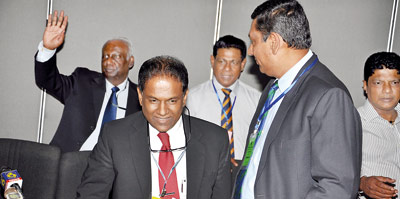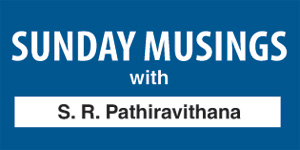Old Pol Roti or a new vision for Lankan cricket
We suppose that we all love ‘Pol Roti’, which is made up with wheat flour, grated coconut, oil and water. I wonder nutrition wise what good it does to you.

Is this a popularity contest or a cricket AGM? Cricket can well afford to go with these acolytes. - Pic Ranjith Perera
Sometimes green chilli and curry leaves are also added to this mixture, but yet again I cannot vouch for the vitamins that it contains or any other health benefits. The cook bakes the flat cakes on a hot flat iron and whichever sides that comes on top is taken as the right side.
Suppose we all Lankans love cricket too. Like Pol Roti that it also is made up of substances, the health benefits of which I know nothing about.
For the past twenty or more years it has contained the same ingredients. Through the years it has had jar fulls of Ranatungas, Sumathipalas and Dharmadasas and at one time or the other, they all were being mixed and baked on the hot iron plate and this time it is no different; the same ‘Roti’ has been served and may be it had its fair share of chilli and karapincha added.
Last Sunday after much deliberation, the SLC’s AGM was held without much untoward incident, although the authorities were ready for all kinds of security measures, forgetting this was only a sports show of hands.
Nonetheless the air was full of speculation with a word from none other than the Prime Minister of the country – Ranil Wickremasinghe to the effect he was contemplating a change in the cricket constitution before or after the elections.
At the completion of the elections, President-elect Thilanga Sumathipala commented quite in favour of a constitutional change, but, Sports Minister Dayasiri Jayasekera in spite of talking on the same line lamented the issue and said that proper protocol was not followed and made some unsavoury comments about the proposer – the outgoing Interim committee chairman Sidath Wettimuny.
However, we learn through the grapevine that the Prime Minister even had consulted ICC chairman Shashank Manohar about the changes and sooner or later they would see the light of day.
Let’s get to the anatomy of the just elected executive committee and what its members are up to. The key issues discussed were: The appointment of the Management Committee consisting of all office bearers.
The following office bearers were appointed to overlook six strategic areas under the business plan of the SLC. They are: Development – Thilanga Sumathipala (President); international cricket – Jayantha Dharmadasa (Vice President); domestic cricket – K. Mathivanan (Vice President); Administration – Mohan de Silva (Secretary); finance – Shammi Silva (Treasurer); and corporate communications – Ravin Wickramaratne (Assistant Secretary) and Lalith Rambukwella (Assistant Treasurer).
Besides, there were some other important decisions taken right at the onset. They were the establishment of a Financial Advisory Committee which will consist of five members as follows:
- An SLC nominate who has local and international cricket experience with a sound financial background
- A representative appointed by the Ministry of Sports.
- A representative from the Ministry of Finance.
- A representative from the Association of Sri Lanka Institute of Chartered Accountants.
- A member with sound financial background from a member Club/Association nominated by SLC.
The setting up of this committee goes in line the plans outlined by the Prime Minister for the cricket’s apex body. The SLC treasurer would be an ex-officio member of this committee.
The executive committee appointed Thilanga Sumathipala to represent Sri Lanka as Director of the International Cricket Council and Jayantha Dharmadasa as the alternate Director of the ICC.
They also decided to appoint Sumathipala to represent Sri Lanka as President of Asian Cricket Council and Mohan de Silva to represent SLC as Director of Asian Cricket Council.
We are not interested in the family ties of Sumathipala or his alleged affiliations with the gaming industry; if at all that is the job of the ICC, let them fill in the blanks on those dotted lines, if they so desire.
Yet, we suppose that with the receding hairlines and years of experience Sumathipala knows better about the gamut of cricket and the intricacies of it — and he too may think that a change of the cricket constitution would do more good than bad to the wellbeing of the game.
If he thinks so, here are some points for him to ponder. For instance, I guess it was cricket that took Sumathipala into politics and it is not the other way round.
Like two grappling pythons, both Arjuna Ranatunga and Thilanga Sumathipala wrestled their way into politics and both reached the pedestal through perseverance.
Now we feel he must brood no politics in national cricket – directly or indirectly.
He must have a re-look at the voting system. Do we need 147 votes in a country where even the northern and the eastern parts are not fully represented?
At the same time, there is a load of deadwood that we keep carrying from election to election. Most of these clubs carry two votes claiming that they are controlling clubs, but we feel that even those very voters are incapable of controlling themselves.
Most are these clubs are defunct or inactive and sometimes limited only to a name board. Contribution wise these clubs do zilch to the betterment of the game.
A vote at a cricket AGM should be a sacred issue with the most deserving being given the chance to air their opinion. This is because we feel the bigger the contribution from them to the national cause, the more control of the game should go to the respective entities.
At the same time having District Associations is a duplication of authority. The Districts Associations should work within the perimeters of the Provincial Associations.
In that manner a huge chunk of 44 votes could be cut off from the equation.
The final count of the voting should be made up of – All 14 Premier Clubs two votes each 28. Emerging clubs, Provinces and Associations one vote each = 10+5+6 = 21 votes.
Affiliated Clubs should be scrutinised and only viable, contributing entities should be given a vote each. It should be a lesser number than the 23 at present.
In that manner the number could be brought down to about 50-60.
Then with a smaller vote base, they also could afford to have a smaller executive committee, instead of the present 22-member outfit — maybe it can be downsized to ten.
Also to the Ex-Co should be attached a professional body with executive powers so that they can maintain checks and balances within the administration. Then at the same this will give the whole gamut the necessary transparency.
May be to give it more credibility, they could name a higher board consisting of a team of professionals including two past captains on the same lines to go through multimillion dollar deals and study their viability from a professional as well as a cricketing angle.

May be if they could draw-up a new frame on these lines it would give the entire cricket administration a new look and more respectability and viability.
They have to make a choice or they can hold on to the status quo and burn the same old Pol Rotties over and over again. Yet, Sumathipala and co must not be afraid to think out of the box.
Maybe, the stakeholders may not understand the value of this proposed change now, but, definitely they would be judged objectively in the future.
| The votes they polled at the cricket elections: Post of President: (1) Thilanga Sumathipala 88 Nishantha Ranatunga 56 The names of Sumith Perera and Jayantha Dharmadasa were withdrawn.Post of Vice Presidents: (2) Jayantha Dharmadasa 102 K. Mathivanan 90 Arjuna Ranatunga 80 Asanga Seneviratne 18 Post of Treasurer: (1) Post of Secretary: (1) Post of Assistant Secretary: (1) Post Assistant Treasurer: (1) |


